Effects of an Owl Airfoil on the Aeroacoustics of a Small Wind Turbine
Abstract
:1. Introduction
2. Numerical Setup and Conditions
2.1. Model Validation
2.2. Prediction of Generated Noise
3. Results and Discussion
3.1. Surface Acoustic
3.2. Streamlines Acoustic
4. Conclusions
Author Contributions
Funding
Data Availability Statement
Conflicts of Interest
References
- Alsop, A.; Eales, A.; Strachan, S.; Leary, J.; Persson, J.; Almeyda, I.R. A global market assessment methodology for small wind in the developing world. In Proceedings of the 2017 IEEE Global Humanitarian Technology Conference (GHTC), San Jose, CA, USA, 19–22 October 2017. [Google Scholar]
- Kwok, K.; Hu, G. Wind energy system for buildings in an urban environment. J. Wind. Eng. Ind. Aerodyn. 2023, 234, 105349. [Google Scholar] [CrossRef]
- Berg, F.V.D. Wind turbine noise: An overview of acoustical performance and effects on residents. In Proceedings of the Acoustics, Victor Harbor, Australia, 17–20 November 2013. [Google Scholar]
- Schmidt, J.H.; Klokker, M. Health Effects Related to Wind Turbine Noise Exposure: A Systematic Review. PLoS ONE 2014, 9, e114183. [Google Scholar] [CrossRef]
- Taylor, J.; Eastwick, C.; Lawrence, C.; Wilson, R. Noise levels and noise perception from small and micro wind turbines. Renew. Energy 2013, 55, 120–127. [Google Scholar] [CrossRef]
- Blumendeller, E.; Gaßner, L.; Müller, F.J.; Pohl, J.; Hübner, G.; Ritter, J.; Cheng, P.W. Quantification of amplitude modulation of wind turbine emissions from acoustic and ground motion recordings. Acta Acust. 2023, 7, 55. [Google Scholar] [CrossRef]
- Rogers, A.L.; Manwell, J.F.; Wright, S. Wind Turbine Acoustic Noise; Renewable Energy Research Laboratory: Amherst, MA, USA, 2006.
- Sagrillo, M. Wind Turbines and Noise; Springer: Berlin/Heidelberg, Germany, 1996. [Google Scholar]
- Wagner, S.; Bareiß, R.; Guidati, G. Wind Turbine Noise; Springer: Stuttgart, Germany, 2012. [Google Scholar]
- Liu, W. A review on wind turbine noise mechanism and de-noising techniques. Renew. Energy 2017, 108, 311–320. [Google Scholar] [CrossRef]
- Zhang, C.Q.; Gao, Z.Y.; Chen, Y.Y.; Dai, Y.J.; Wang, J.W.; Zhang, L.R.; Ma, J.L. Locating and tracking sound sources on a horizontal axis wind turbine using a compact microphone array based on beamforming. Appl. Acoust. 2019, 146, 295–309. [Google Scholar] [CrossRef]
- Oerlemans, S.; Sijtsma, P.; López, B.M. Location and quantification of noise sources on a wind turbine. J. Sound Vib. 2007, 299, 869–883. [Google Scholar] [CrossRef]
- Wagner, S.; Bareiß, R.; Guidati, G. Noise Mechanisms of Wind Turbines. In Wind Turbine Noise; Springer: Berlin, Germany, 1996; pp. 67–92. [Google Scholar] [CrossRef]
- Lee, S.; Lee, S. Numerical and experimental study of aerodynamic noise by a small wind turbine. Renew. Energy 2014, 65, 108–112. [Google Scholar] [CrossRef]
- Serre, R.; Godsk, K.B.; Vronsky, T. Scales of turbulence on a wind turbine leading-edge. In Proceedings of the Wind Turbine Noise Conference, Lisbon, Portugal, 12–14 June 2019. [Google Scholar]
- Lilley, G.M. The Radiated Noise from Isotropic Turbulence Revisited; NASA Langley Research Center: Hampton, VA, USA, 1993.
- Proudman, I. The Generation of Noise by Isotropic Turbulence. Proc. R. Soc. Lond. Ser. A Math. Phys. Sci. 1952, 214, 119–132. [Google Scholar] [CrossRef]
- Latoufis, K.; Riziotis, V.; Voutsinas, S.; Hatziargyriou, N. Effects of Leading Edge Erosion on the Power Performance and Acoustic Noise Emissions of Locally Manufactured Small Wind Turbine Blades. J. Phys. 2019, 10, 1742–6596. [Google Scholar] [CrossRef]
- Brooks, T.F.; Pope, D.S.; Marcolini, M.A. Airfoil Self-Noise and Prediction; National Aeronautics and Space Administration: Washington, DC, USA, 1989.
- Con Doolan, D.M. Airfoil Noise Mechanisms and Control. In Flow Noise; Springer: Singapore, 2022; pp. 139–171. [Google Scholar] [CrossRef]
- Amirsalari, B.; Rocha, J. Recent Advances in Airfoil Self-Noise Passive Reduction. Aerospace 2023, 10, 791. [Google Scholar] [CrossRef]
- Zhu, W.J.; Heilskov, N.; Shen, W.Z.; Sørensen, J.N. Modeling of Aerodynamically Generated Noise from Wind Turbines. J. Sol. Energy Eng. 2005, 127, 517–528. [Google Scholar] [CrossRef]
- Junior, J.Y.S. Trailing-Edge Noise Development and Application of a Noise Prediction Tool for the Assessment and Design of Wind Turbine Airfoils; Escola Politécnica: São Paulo, Brasil, 2016. [Google Scholar]
- Clifton-Smith, M.J. Aerodynamic Noise Reduction for Small Wind Turbine Rotors. Wind. Eng. 2010, 34, 403–420. [Google Scholar] [CrossRef]
- Pourrajabian, A.; Rahgozar, S.; Dehghan, M.; Wood, D. A comprehensive multi-objective optimization study for the aerodynamic noise mitigation of a small wind turbine. Eng. Anal. Bound. Elements 2023, 155, 553–564. [Google Scholar] [CrossRef]
- Deshmukh, S.; Bhattacharya, S.; Jain, A.; Paul, A.R. Wind turbine noise and its mitigation techniques: A review. Energy Procedia 2019, 160, 633–640. [Google Scholar] [CrossRef]
- Rahgozar, S.; Pourrajabian, A.; Kazmi, S.M.R. Performance analysis of a small horizontal axis wind turbine under the use of linear/nonlinear distributions for the chord and twist angle. Energy Sustain. Dev. 2020, 58, 42–49. [Google Scholar] [CrossRef]
- Volkmer, K.; Kaufmann, N.; Carolus, T.H. Mitigation of the aerodynamic noise of small axial wind turbines—Methods and experimental validation. J. Sound Vib. 2021, 500, 116027. [Google Scholar] [CrossRef]
- León, C.A.; Merino-Martínez, R.; Ragni, D.; Avallone, F.; Scarano, F.; Pröbsting, S.; Snellen, M.; Simons, D.G.; Madsen, J. Effect of trailing edge serration-flow misalignment on airfoil noise emissions. J. Sound Vib. 2017, 405, 19–33. [Google Scholar] [CrossRef]
- Zhao, M.; Cao, H.; Zhang, M.; Liao, C.; Zhou, T. Optimal design of aeroacoustic airfoils with owl-inspired trailing-edge serrations. Bioinspiration Biomim. 2021, 16, 056004. [Google Scholar] [CrossRef] [PubMed]
- Rao, C.; Ikeda, T.; Nakata, T.; Liu, H. Owl-inspired leading-edge serrations play a crucial role in aerodynamic force production and sound suppression. Bioinspiration Biomim. 2017, 12, 046008. [Google Scholar] [CrossRef] [PubMed]
- Bodling, A.; Sharma, A. Numerical investigation of low-noise airfoils inspired by the down coat of owls. Bioinspiration Biomim. 2018, 14, 016013. [Google Scholar] [CrossRef] [PubMed]
- Wang, L.; Liu, X. Aeroacoustic investigation of asymmetric oblique trailing-edge serrations enlighted by owl wings. Phys. Fluids 2022, 34, 015113. [Google Scholar] [CrossRef]
- Wang, L.; Liu, X.; Li, D. Noise reduction mechanism of airfoils with leading-edge serrations and surface ridges inspired by owl wings. Phys. Fluids 2021, 33, 015123. [Google Scholar] [CrossRef]
- Li, D.; Liu, X.; Hu, F.; Wang, L. Effect of trailing-edge serrations on noise reduction in a coupled bionic aerofoil inspired by barn owls. Bioinspiration Biomim. 2019, 15, 016009. [Google Scholar] [CrossRef] [PubMed]
- Geyer, T.; Sarradj, E.; Fritzsche, C. Measuring owl flight noise. In Proceedings of the INTER-NOISE and NOISE-CON Congress and Conference Proceedings, Melbourne, Australia, 16–19 November 2014. [Google Scholar]
- Graham, R.R. The Silent Flight of Owls. J. R. Aeronaut. Soc. 1934, 38, 837–843. [Google Scholar] [CrossRef]
- Liang, G.Q.; Wang, J.C.; Chen, Y.; Zhou, C.H.; Liang, J.; Ren, L.Q. The Study of Owl’s Silent Flight and Noise Reduction on Fan Vane with Bionic Structure. Adv. Nat. Sci. 2010, 3, 192–198. [Google Scholar]
- Wagner, H.; Weger, M.; Klaas, M.; Schröder, W. Features of owl wings that promote silent flight. Interface Focus 2017, 7, 20160078. [Google Scholar] [CrossRef] [PubMed]
- Göçmen, T.; Özerdem, B. Airfoil optimization for noise emission problem and aerodynamic performance criterion on small scale wind turbines. Energy 2012, 46, 62–71. [Google Scholar] [CrossRef]
- Jones, R.; Doolan, C.J.; Teubner, M. Minimization of trailing edge noise by parametric airfoil shape modifications. In Proceedings of the 32nd AIAA Aeroacoustics Conference, Portland, OR, USA, 5–8 June 2012. [Google Scholar]
- Li, D.; Wei, C. Numerical Study on Aerodynamic and Aeroacoustic Performances of Bioinspired Wings. Appl. Bionics Biomech. 2023, 2023, 9930841. [Google Scholar] [CrossRef]
- Bodling, A.; Sharma, A. Numerical investigation of noise reduction mechanisms in a bio-inspired airfoil. J. Sound Vib. 2019, 453, 314–327. [Google Scholar] [CrossRef]
- Wang, M.; Liu, X. Numerical investigation of aerodynamic and acoustic characteristics of bionic airfoils inspired by bird wing. Proc. Inst. Mech. Eng. Part G J. Aerosp. Eng. 2019, 233, 4004–4016. [Google Scholar] [CrossRef]
- Qin, S.; Cheng, L.; He, Z. Bionic Fan Blade Shape Design Based on Owl Airfoil and Analysis of Its Effect on Noise. In Advances in Mechanical Design; Springer Nature Singapore Pte Ltd.: Singapore, 2022; pp. 665–672. [Google Scholar] [CrossRef]
- Liu, X.; Liu, X. A Numerical Study of Aerodynamic Performance and Noise of a Bionic Airfoil Based on Owl Wing. Adv. Mech. Eng. 2014, 6, 859308. [Google Scholar] [CrossRef]
- Li, D.; Liu, X. A comparative study on aerodynamic performance and noise characteristics of two kinds of long-eared owl wing models. J. Mech. Sci. Technol. 2017, 31, 3821–3830. [Google Scholar] [CrossRef]
- Tu, J.; Yeoh, G.H.; Liu, C.; Tao, Y. Computational Fluid Dynamics: A Practical Approach, 3rd ed.; Butterworth-Heinemann: Oxford, UK, 2012. [Google Scholar]
- Suárez, J.M.; Doerffer, P.; Szulc, O. CFD Validated Technique for Prediction of Aerodynamic Characteristics on Horizontal Axis Wind Energy Turbines. In Proceedings of the EWEA Offshore, Copenhagen, Denmark, 10–12 March 2015. [Google Scholar]
- Liu, T.; Kuykendoll, K.; Rhew, R.; Jones, S. Avian Wing Geometry and Kinematics. AIAA J. 2006, 44, 954–963. [Google Scholar] [CrossRef]
- WebPlotDigitizer. Available online: https://apps.automeris.io/wpd/ (accessed on 15 January 2023).
- Hand, M.M.; Simms, D.A.; Fingersh, L.J.; Jager, D.W.; Cotrell, J.R.; Schreck, S.; Larwood, S.M. Unsteady Aerodynamics Experiment Phase VI: Wind Tunnel Test Configurations and Available Data Campaigns; National Renewable Energy Laboratory: Golden, CO, USA, 2001.
- BY 80-/80- BY 120-Foot Wind Tunnels. NASA Ames Research Center. Available online: https://rotorcraft.arc.nasa.gov/Research/Facilities/windtunnels.html (accessed on 15 January 2023).
- Song, Y.; Perot, J.B. CFD Simulation of the NREL Phase VI Rotor. Wind. Eng. 2015, 39, 299–310. [Google Scholar] [CrossRef]
- Yelmule, M.M.; Vsj, E.A. CFD predictions of NREL Phase VI Rotor Experiments in NASA/AMES Wind tunnel. Int. J. Renew. Energy Res. 2013, 3, 261–269. [Google Scholar]
- Sørensen, N.N.; Michelsen, J.A.; Schreck, S. Navier–Stokes predictions of the NREL phase VI rotor in the NASA Ames 80 ft × 120 ft wind tunnel. Wind Energy 2002, 5, 151–169. [Google Scholar] [CrossRef]
- Johansen, J.; Sørensen, N.N.; Michelsen, J.A.; Schreck, S. Detached-Eddy Simulation of Flow Around the NREL Phase-VI Blade. In Proceedings of the Wind Energy Symposium, Reno, NV, USA, 14–17 January 2002. [Google Scholar]
- Ansys. Available online: https://ansyshelp.ansys.com/account/secured?returnurl=/Views/Secured/corp/v221/en/flu_ug/x1-151000023.6.1.html (accessed on 30 January 2024).
- Lilley, G.M. The radiated noise from isotropic turbulence. Theor. Comput. Fluid Dyn. 1994, 6, 281–301. [Google Scholar] [CrossRef]
- Bechara, W.; Bailly, C.; Lafon, P.; Candel, S.M. Stochastic approach to noise modeling for free turbulent flows. AIAA J. 1994, 23, 455–463. [Google Scholar] [CrossRef]

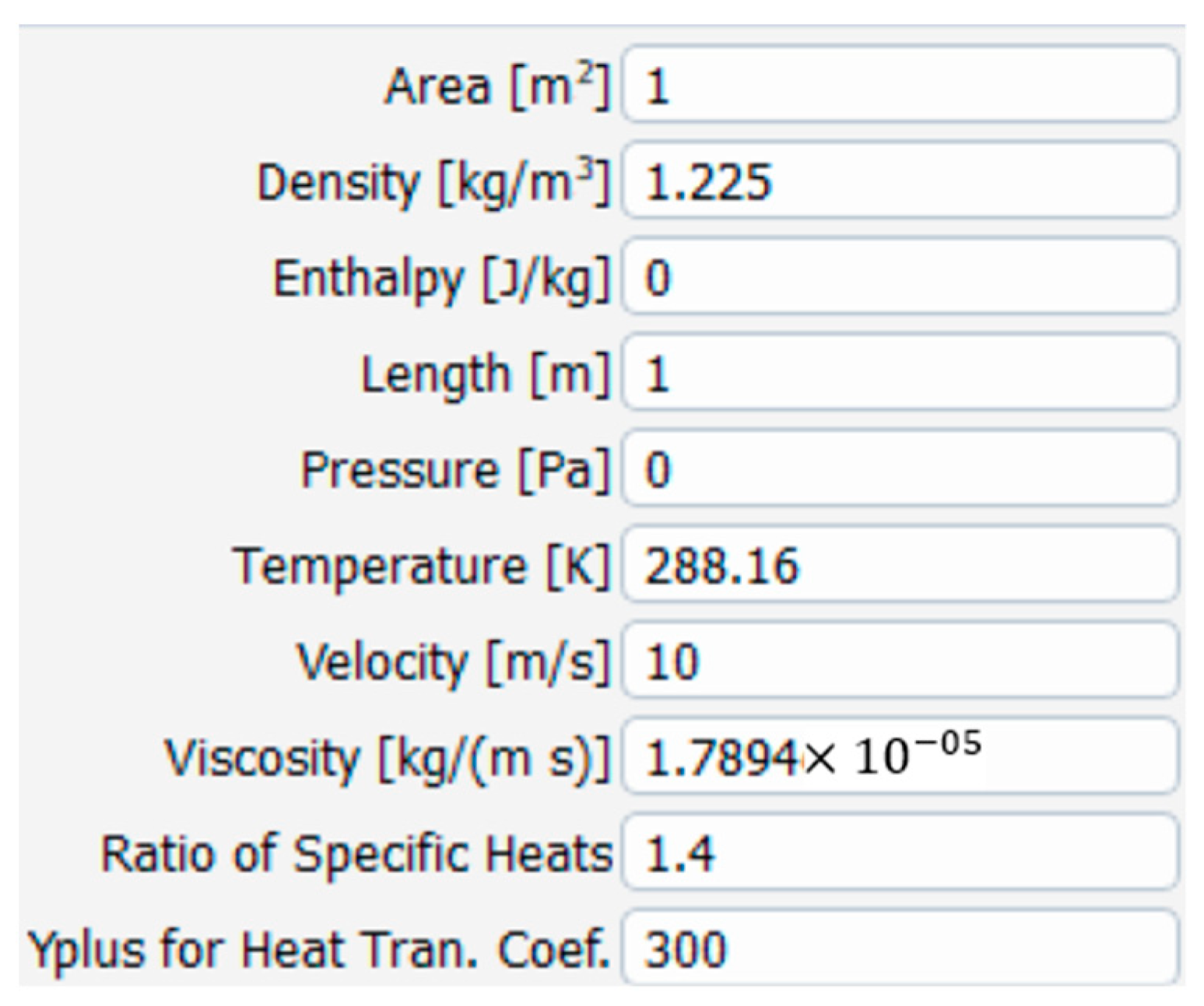


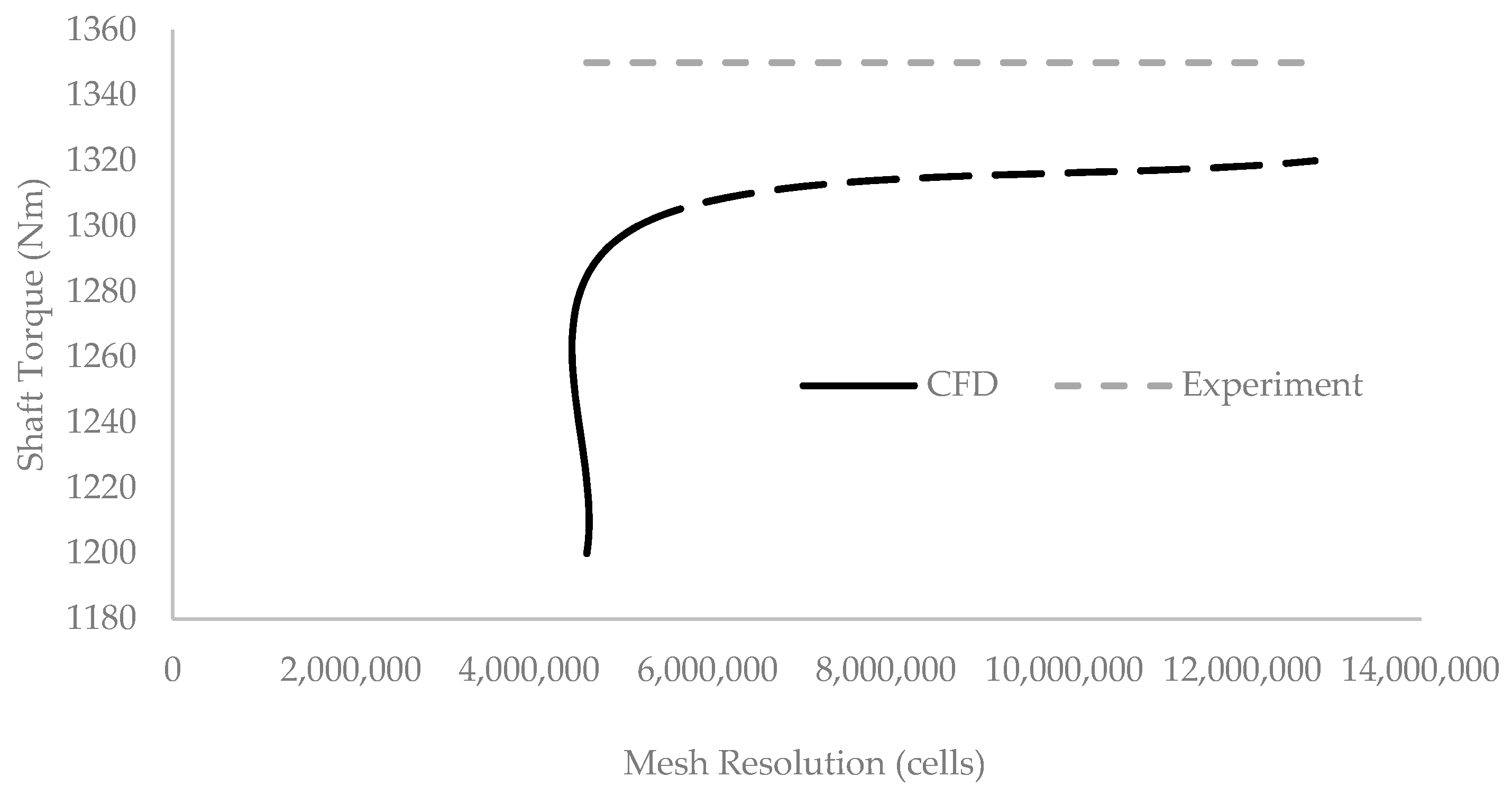

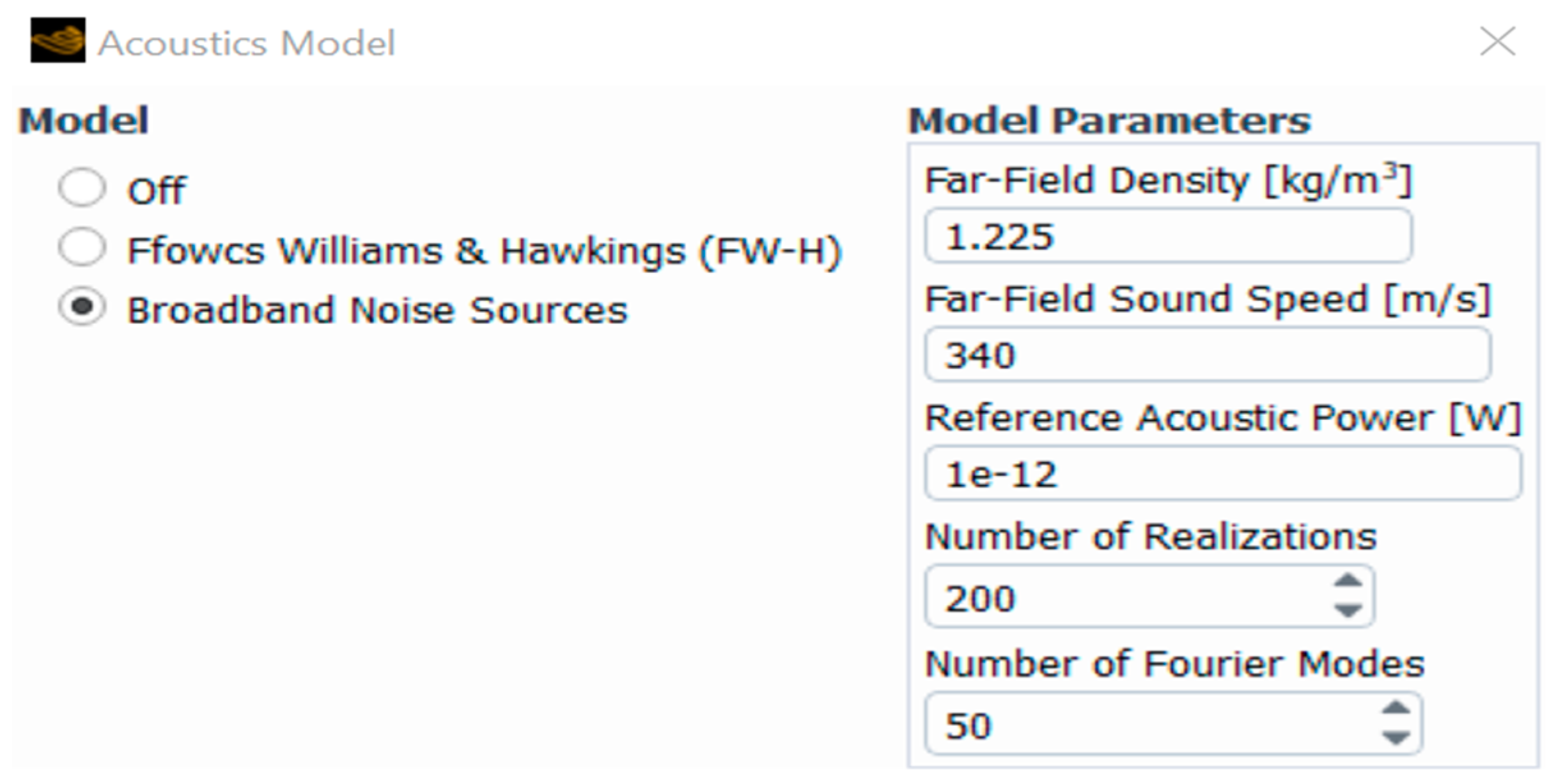
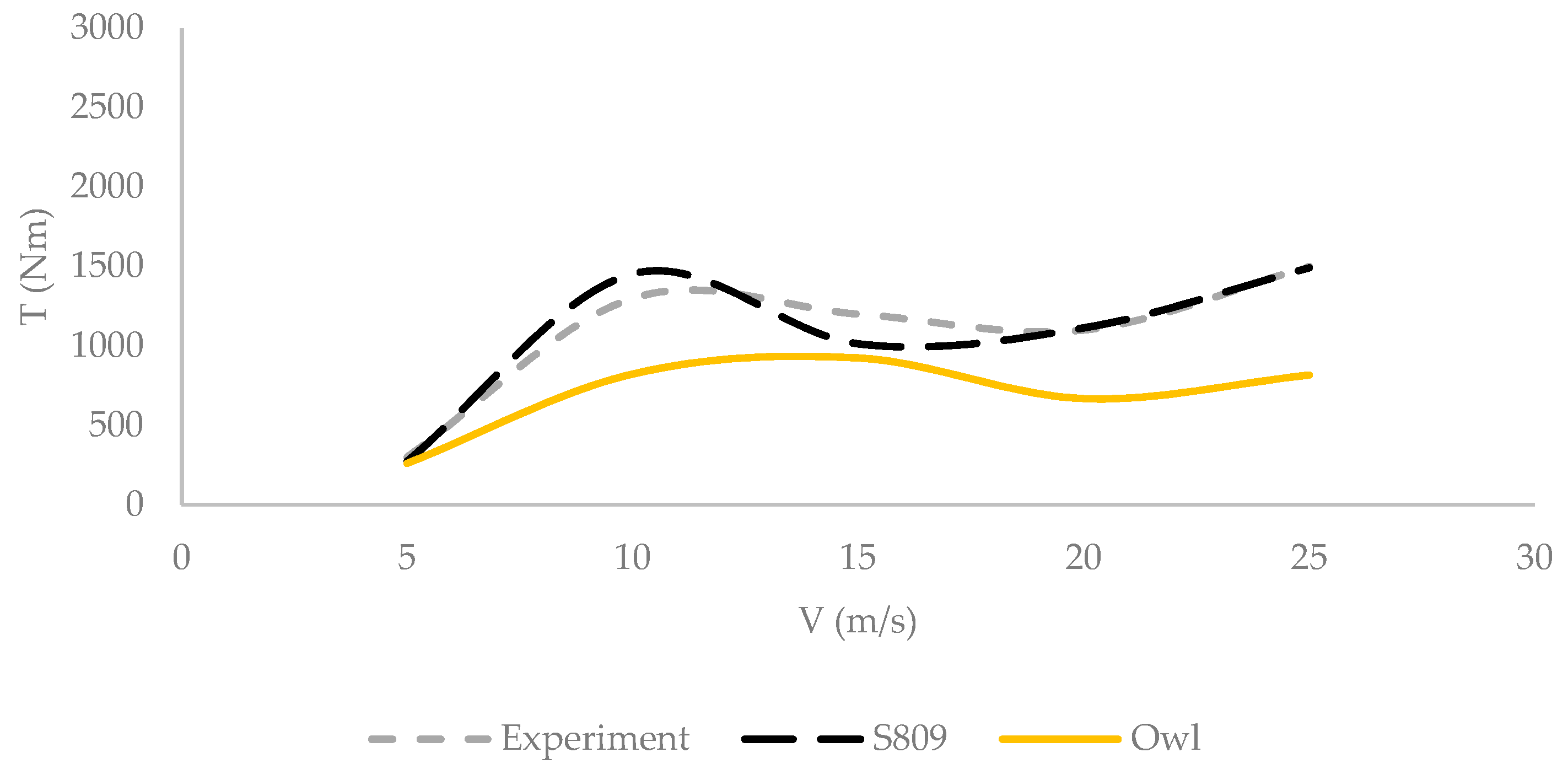
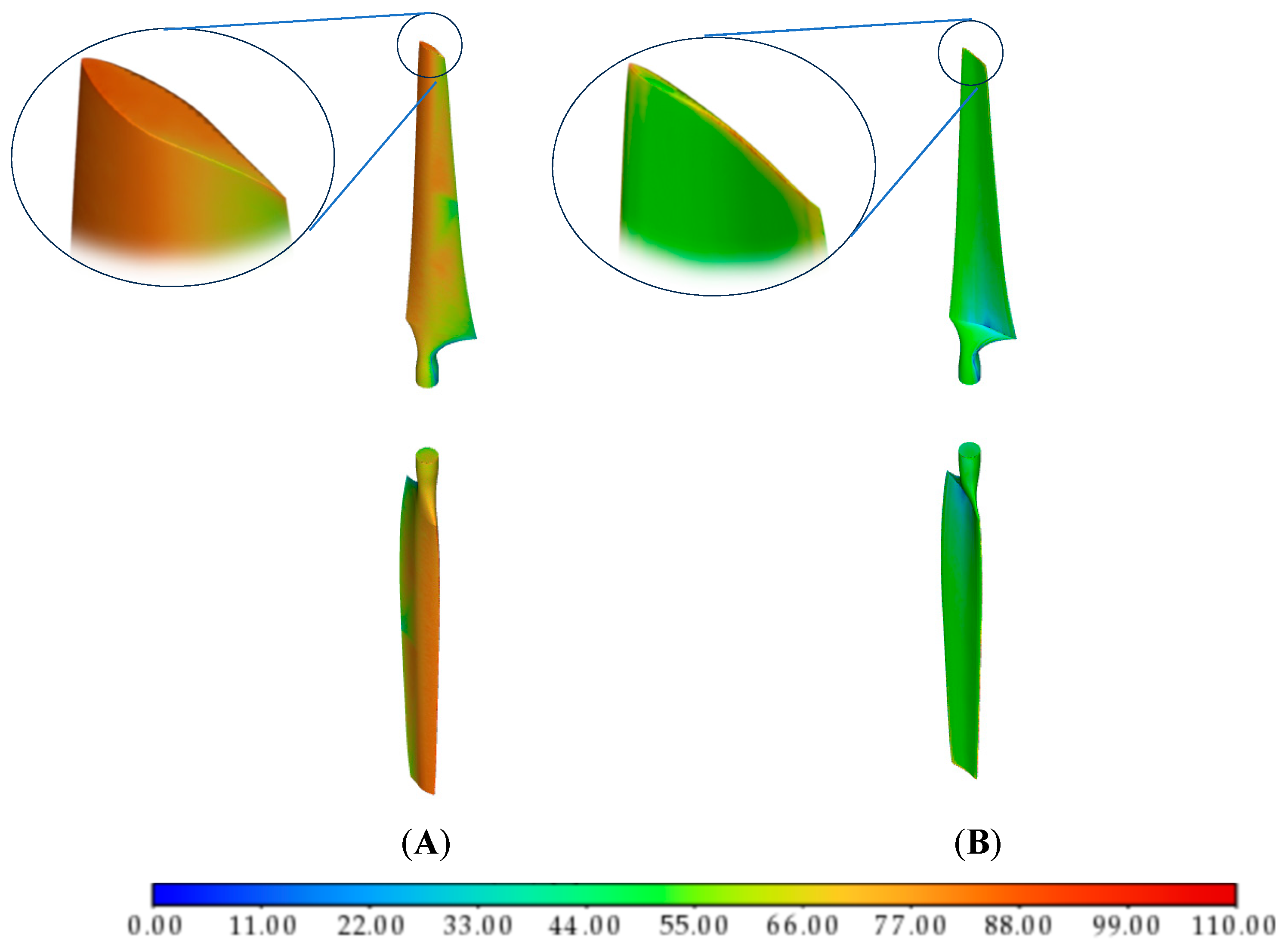
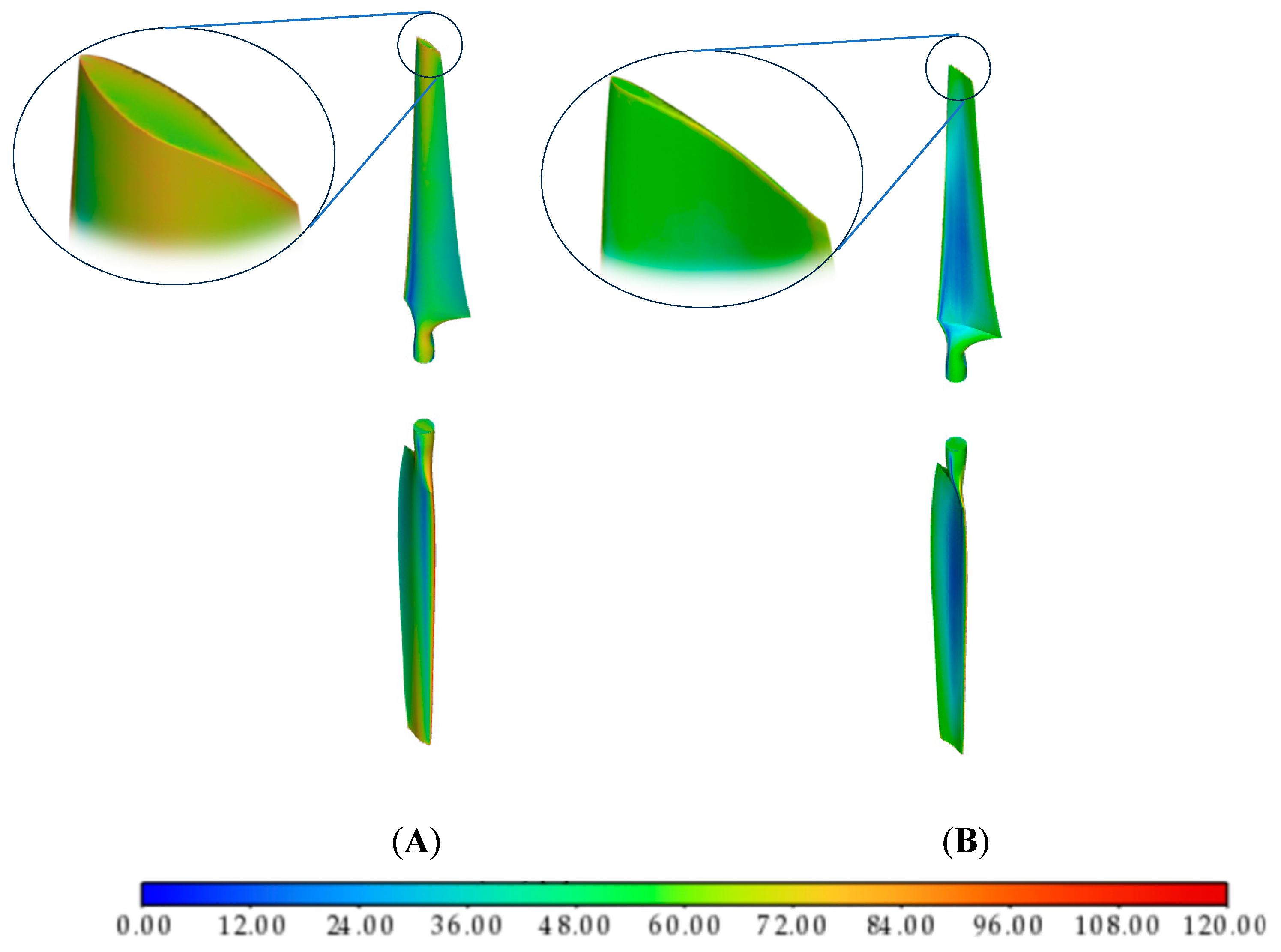


| Upper Surface | Lower Surface |
|---|---|
| x/c | x/c |
| y/c | y/c |
| 1 | 0.915 |
| 0.95246 | 0.91575 |
| 0.91758 | 0.91902 |
| 0.88269 | 0.92286 |
| 0.82482 | 0.93 |
| 0.79562 | 0.93389 |
| 0.73761 | 0.94192 |
| 0.6734 | 0.949 |
| 0.60469 | 0.955 |
| 0.56907 | 0.9575 |
| 0.49899 | 0.961 |
| 0.4641 | 0.96179 |
| 0.42922 | 0.962 |
| 0.35946 | 0.96226 |
| 0.28969 | 0.961 |
| 0.25481 | 0.96 |
| 0.21992 | 0.95841 |
| 0.18504 | 0.957 |
| 0.15016 | 0.955 |
| 0.11528 | 0.951 |
| 0.080395 | 0.94606 |
| 0.047098 | 0.9391 |
| 0.026485 | 0.90258 |
| 0.061368 | 0.90025 |
| 0.13113 | 0.90771 |
| 0.16602 | 0.914 |
| 0.2009 | 0.92018 |
| 0.23578 | 0.926 |
| 0.27066 | 0.93219 |
| 0.34043 | 0.94221 |
| 0.37531 | 0.947 |
| 0.41019 | 0.95 |
| 0.44508 | 0.952 |
| 0.47996 | 0.953 |
| 0.55104 | 0.951 |
| 0.58461 | 0.94839 |
| 0.69221 | 0.938 |
| 0.77226 | 0.92917 |
| 0.8073 | 0.925 |
| 0.88269 | 0.918 |
| 0.95246 | 0.913 |
| 1 | 0.915 |
| Radial Distance R (m) | Span Station (R/5.029) | Chord Length (m) | Twist (Degrees) | Thickness (m) (20.95% Chord) | Twist Axis (% Chord), (m) |
|---|---|---|---|---|---|
| 0.0 | 0.0 | Hub-center of rotation | Hub-center of rotation | Hub-center of rotation | Hub-center of rotation |
| 0.508 | 0.101 | 218 (Root hub adapter) | 0.0 (Root hub adapter) | 0.218 (Root hub adapter) | 50 (Root hub adapter) |
| 0.660 | 0.131 | 0.218 | 0.0 | 0.218 | 50 |
| 0.883 | 0.176 | 0.183 | 0.0 | 0.183 | 50 |
| 1.257 | 0.250 | 0.737 | 20.040 | 0.154 | 30, (0.221) |
| 1.343 | 0.267 | 0.728 | 18.074 | 0.152 | 30, (0.218) |
| 1.510 | 0.300 | 0.711 | 14.292 | 0.149 | 30, (0.213) |
| 1.648 | 0.328 | 0.697 | 11.909 | 0.146 | 30, (0.209) |
| 1.952 | 0.388 | 0.666 | 7.979 | 0.139 | 30, (0.199) |
| 2.257 | 0.449 | 0.636 | 5.308 | 0.133 | 30, (0.190) |
| 2.343 | 0.466 | 0.627 | 4.715 | 0.131 | 30, (0.188) |
| 2.562 | 0.509 | 0.605 | 3.425 | 0.126 | 30, (0.181) |
| 2.867 | 0.570 | 0.574 | 2.083 | 0.120 | 30, (0.172) |
| 3.172 | 0.631 | 0.543 | 1.150 | 0.113 | 30, (0.162) |
| 3.185 | 0.633 | 0.542 | 1.115 | 0.113 | 30, (0.162) |
| 3.476 | 0.691 | 0.512 | 0.494 | 0.107 | 30, (0.153) |
| 3.781 | 0.752 | 0.482 | −0.015 | 0.100 | 30, (0.144) |
| 4.023 | 0.800 | 0.457 | −0.381 | 0.095 | 30, (0.137) |
| 4.086 | 0.812 | 0.451 | −0.475 | 0.094 | 30, (0.135) |
| 4.391 | 0.873 | 0.420 | −0.920 | 0.088 | 30, (0.162) |
| 4.696 | 0.934 | 0.389 | −1.352 | 0.081 | 30, (0.116) |
| 4.780 | 0.950 | 0.381 | −1.469 | 0.079 | 30, (0.114) |
| 5.000 | 0.994 | 0.358 | −1.775 | 0.075 | 30, (0.107) |
| 5.029 | 1 | 0.335 | −1.944 | 0.075 | 30, (0.101) |
Disclaimer/Publisher’s Note: The statements, opinions and data contained in all publications are solely those of the individual author(s) and contributor(s) and not of MDPI and/or the editor(s). MDPI and/or the editor(s) disclaim responsibility for any injury to people or property resulting from any ideas, methods, instructions or products referred to in the content. |
© 2024 by the authors. Licensee MDPI, Basel, Switzerland. This article is an open access article distributed under the terms and conditions of the Creative Commons Attribution (CC BY) license (https://creativecommons.org/licenses/by/4.0/).
Share and Cite
Sesalim, D.; Naser, J. Effects of an Owl Airfoil on the Aeroacoustics of a Small Wind Turbine. Energies 2024, 17, 2254. https://doi.org/10.3390/en17102254
Sesalim D, Naser J. Effects of an Owl Airfoil on the Aeroacoustics of a Small Wind Turbine. Energies. 2024; 17(10):2254. https://doi.org/10.3390/en17102254
Chicago/Turabian StyleSesalim, Dean, and Jamal Naser. 2024. "Effects of an Owl Airfoil on the Aeroacoustics of a Small Wind Turbine" Energies 17, no. 10: 2254. https://doi.org/10.3390/en17102254
APA StyleSesalim, D., & Naser, J. (2024). Effects of an Owl Airfoil on the Aeroacoustics of a Small Wind Turbine. Energies, 17(10), 2254. https://doi.org/10.3390/en17102254







